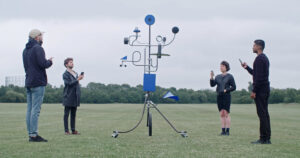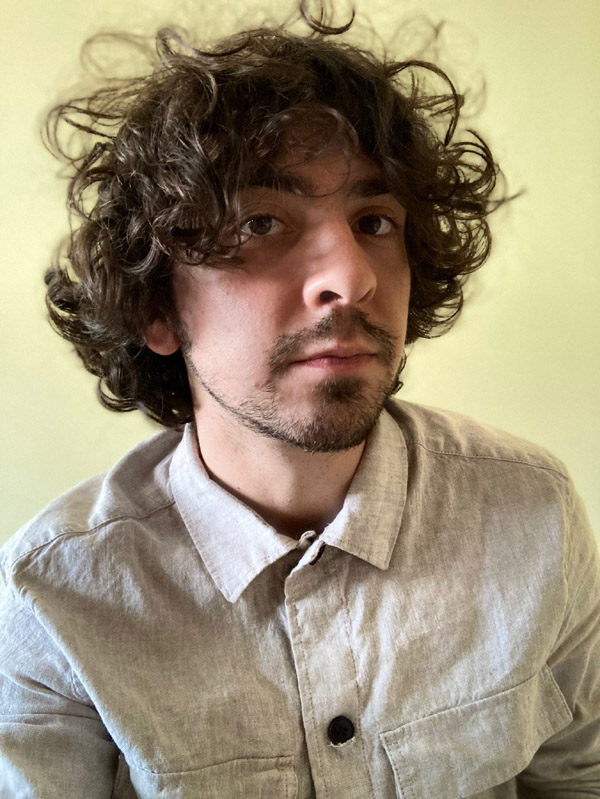Fragmentin is an art collective founded in 2014 in Lausanne. It is formed by Marc Dubois (1985), David Colombini (1989) and Laura Perrenoud (1991): they’re three Alumni of ECAL (Lausanne University of Art and Design) whose works testify to a research that interwines formal research and engineering skills, sculptural language and digital knowledge: works that go beyond the aesthetic dimension to stimulate critical discussions on some contemporary issues.
Among these stands out the relationship between digital technology and daily life, crucial when the predictive logic of algorythms influences choices and personal tastes, gradually eliminating any randomness from the daily exploration of the world. Activist Eli Pariser has called this phenomenon ‘Filter Bubble’ in his own text “The Filter Bubble: What The Internet Is Hiding From You” published in 2012 by Penguin Books.
How to recreate, then, any randomness margins in a system increasingly enclosed by codes of information that foresee the future as infallible contemporary sybils?
‘The Weather Followers’ is a 2017 project by David Colombini. Besides being a sculpture reminiscent of the sinuosity of the forms of the painter Joan Mirò, it is also a weather station upon which four climate detectors are installed. They are linked to an app activated by the user. A central element is meteorological wheather, one of the greatest sources of unpredictability that have always characterized human life on Earth. This work and application configure constant new and different scenarios, because it’s the nature’s casuality to dictate the rules of this meeting. Specifically, entering the app, you can access to four different experiences, each related to a particular natural element.
Through ‘Windy Encounters’ the user is invited to draw and sign a sketch that will then be launched into the atmosphere, whereby it will travel following the direction and intensity of the wind (recorded by the detector on the sculpture) until its landing on another person’s device with the same application. Then the receiver can decide to contact the sender via e-mail; the result is a completely random encounter that has been made possible by the unpredictability of the wind and its currents.
Then there’s ‘Polluted Selfie’. By considering real-time readings of air pollution levels each selfie will be altered by CO2 amount, which will change the overall hue, and PM10, which will provoke a glitch in the image. Unsettling alterations, compared to the corrective aesthetics of Instagram filters or other photo-editing apps, yet revealing bodies as invisible as they are present. In addition to that, the image is saturated by pop- up windows that show daily values of air pollution through a link with the Londonair.org.uk data, referring to 90s Net Art aesthetics.
Perhaps ‘Drizzly Rhythms’ is the most playful component of the work: songs picked by the user are altered in relation to the rhythm of rain that impacts the sculpture. A sensor records the amount of DPM (Rain Drop per Minute) and relates it to the BPM (Beat per Minute) value of a playlist suggested by the user, creating unexpected music that constantly changes as well as the rain that generates them.
Finally, we arrive at the provocative ‘Sun(e)rase’: the intensity of the sun rays resting on the sculpture decides the amount of data deletion from user’s mobile phone. The elimination materializes itself with a self- adjusted lens that conveys the sun’s rays on the underlying surface, highlighting the burning process. Here the sun affects the now mythical intangibility of virtual archives, making them burn like organic bodies exposed to nature.
‘The Weather Followers’ triggers a spectrum of different experiences linked by the red thread of Chance. The nature’s random character immerses the user in an increasingly rare experience nowadays: the one of the ‘unexpected’.
This work, however, does not show itself as a direct report of technology’s influence on daily life, but it casts a playful look that swings wisely between the game and the committed criticism, also drawing on a poetic dimension: a machine that has an input but not a defined output, when it starts random and always different processes; but also a machine that, in relation to the increasingly developed Machine Learning systems, shows itself to be weak, ‘unproductive’ in revealing a renewed relationship with the surrounding nature.
Finally, a common feature between poetry and play is the political component of ‘The Weather Followers’: by exposing daily actions to the mystery of nature, the work makes the user no longer a spectator of a future already defined, but a participant of a developing world.
Piermario De Angelis
Info:
 Fragmentin, The Weather Followers, steel, aluminum, electronic components (weather sensors, Raspberry Pi, Raspi Camera), acrylic, rubber, glass, waterproof speakers, amplifier, power supply, blue paint, software: Python, arduino, PHP, JS, HTML, CSS, 140 x 140 x 242 cm, installation view with users, 2017
Fragmentin, The Weather Followers, steel, aluminum, electronic components (weather sensors, Raspberry Pi, Raspi Camera), acrylic, rubber, glass, waterproof speakers, amplifier, power supply, blue paint, software: Python, arduino, PHP, JS, HTML, CSS, 140 x 140 x 242 cm, installation view with users, 2017
 Fragmentin, The Weather Followers, 2017, detail
Fragmentin, The Weather Followers, 2017, detail
 Fragmentin, The Weather Followers app’s graphic interfaces
Fragmentin, The Weather Followers app’s graphic interfaces
 Fragmentin, The Weather Followers – Polluted Selfie, 2017
Fragmentin, The Weather Followers – Polluted Selfie, 2017

Piermario De Angelis was born in Pescara on 06/10/1997. After graduating from high school he moved to Milan to attend the three-year degree course in Arts, Design and Entertainment at the IULM university. He is currently a second year student of the two-year course of Visual Cultures and Curatorial Practices at the Brera Academy of Fine Arts. He is a contributor for ‘Juliet Art Magazine’ and ‘Kabul Magazine’. In 2021 he co-founded, together with other students of the Brera Academy, the non-profit cultural association Genealogie Del Futuro: a reality that addresses socio-political and environmental issues through alternative community building practices, through an artistic and curatorial perspective. His research aims to be an exploration of the critical potential of art and images in relation to the urgencies of contemporaneity.






NO COMMENT